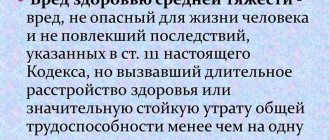Harm to health can be caused in various circumstances.
In each specific case, the degree of harm caused is determined based on a special medical examination. Based on its results, the degree of harm caused is determined: mild, moderate or severe. Based on this indicator, it is determined what amount of compensation should be paid to the victim. Dear readers! To solve your specific problem, call the hotline or visit the website. It's free.
8 (800) 350-31-84
What is compensation and when is it required?
Compensation for harm to health is a special payment that is appointed by the court as part of the consideration of a criminal case on the fact of causing harm to health as a result of an attempt on the life and health of the victim, committed intentionally or unintentionally.
Damage to health can be caused as a result of a direct attack (for example, if we are talking about a robbery) or as a result of surrounding circumstances (for example, in the event of a traffic accident). Depending on the extent to which such damage to health was caused, compensation for the damage caused will be calculated.
This payment from the perpetrator is required in cases where, due to the harm caused, the victim has to remain without work for a long time (temporary or permanent loss of ability to work) or if we are talking about a minor whose future performance may be affected by the damage caused at a particular point in time.
Criteria by which the presence of moral damage is determined
Moral damage, despite its definition in current legislation, belongs to the category of concepts that are quite difficult to assess.
Moral damage of the Civil Code of the Russian Federation (Article 151) refers to suffering of a physical or moral nature that a citizen experiences due to a violation of his rights as a result of unlawful actions (or failure to perform necessary actions) of any persons. Additional explanations for this definition are provided in two resolutions of the Plenum of the Supreme Court of the Russian Federation: dated December 20, 1994 No. 10 and dated January 26, 2010 No. 1. Among the rights that may be violated are the following rights (clause 2 of resolution No. 10):
- for life;
- health;
- human dignity;
- business reputation;
- privacy;
- maintaining personal, medical, family secrets;
- use of your name;
- authorship;
- property;
- not causing distress due to the loss of: loved ones;
- work;
- opportunities to lead an active life.
A prerequisite for the emergence of claims for compensation for moral damage is the presence of guilt of the person who caused this harm (clause 32 of Resolution No. 1). As an exception to this rule, situations are considered when harm occurs as a result (Article 1100 of the Civil Code of the Russian Federation):
- impact on life or health of a source of increased danger;
- illegal bringing to criminal or administrative liability;
- dissemination of information discrediting honor, dignity or business reputation;
- other circumstances provided for by law.
Thus, each case of causing moral harm requires individual consideration, taking into account all available factors and the presence of evidence that harm actually occurred.
Legal basis
Regulation of calculations of compensation for causing harm is carried out at the level of several regulations at the federal level:
- Rules for determining the severity of harm caused to health. These rules were adopted by the Government of the Russian Federation in August 2007 to facilitate the determination of the severity of harm caused to health as a result of any criminal acts. Based on the results of the final examination, compensation for damage to health is calculated;
- The Civil Code of the Russian Federation is the main regulator for making calculations for necessary payments. This regulatory act regulates not only the calculation procedure, but also the procedure for assigning such compensation for payment;
- The Code of Criminal Procedure is the normative act on the basis of which the payment of such compensation is made in the process of sentencing in a particular criminal case.
Features of the crime
In most cases, death threats appear in conflict situations in which neighbors or relatives are participants.
A specific feature of this criminal act is that it is expressed only in verbal form, without applying physical force to the victim.
Note!
The danger of a crime lies in the creation of a certain psychologically traumatic environment for the victim - he is in constant fear and worries about his own life. Even if the subject does not intend to carry out the threats, the peace of mind of the victim is violated, and this is regarded as an attack on health.
Considering cases qualified under Art. 119 of the Criminal Code of the Russian Federation, the court faces certain difficulties. The fact that statements containing threats were made to the victim is difficult to prove, and people usually do not know how to prove a threat to kill without witnesses. The situation is simpler if threats are voiced in a telephone conversation or sent in writing.
Criminal case under Art. 119 of the Criminal Code of the Russian Federation is initiated only at the initiative of the injured party. In order to defend their rights and legitimate interests and achieve a conviction for the aggressor, the victim will have to face many difficulties in the criminal process.
The corpus delicti provided for in Art. 119 of the Criminal Code of the Russian Federation, is formed only if there are real grounds to believe that the expressed threat can be carried out. To do this, it is important to evaluate the situation in which she speaks out, the personality of the subject and many other circumstances. A simple verbal statement cannot be considered a real threat. The subjective opinion of the victim that he took the threat seriously, and he had real fears for his life, to qualify the act under Art. 119 of the Criminal Code of the Russian Federation is not enough. Only the circumstances that caused the victim to fear that the threat could be carried out are taken into account, for example, the one who is accused of threatening to kill had a weapon that he put to the vital organs of the victim, was in inadequate condition, etc.
Note!
The threat must contain the intent to kill the victim or cause serious harm to his health. If there is a threat of causing other harm or damage to property, no crime is formed.
Payment procedure
When making calculations regarding what amount should be reimbursed, the following factors are taken into account:
- age of the victim. Until the victim reaches the age of fourteen, only the amount that can be spent or has already been spent on treatment is taken into account (if the treatment is long-term, then the amount that can be demanded to be paid in court is calculated based on the necessary treatment measures and the cost of services for their implementation). In addition, the lost earnings of the parent or other legal representative who cares for the victim are taken into account;
- if we are talking about a person whose age ranges from fourteen to eighteen years, then the calculation of the compensation payment includes not only the amount spent on treatment, but also possible lost earnings during the recovery period of the victim if he worked. If the victim does not have official employment, then only the amount of treatment expenses is taken into account when making the calculation;
- if we are talking about a victim who has reached the age of eighteen years, then the calculation of compensation is made on the basis of the lost earnings of such a person. If such a person did not have a regular income, for example, due to studying full-time at a vocational educational institution, then the calculation will be made based on the cost of treatment and restoration of working capacity, if any, was lost.
In order for compensation to be calculated in full, it is necessary to save all documents that confirm the implementation of certain treatment options, checks and payment receipts for payment for certain medical procedures, as well as medicines that were purchased during the treatment period, rehabilitation route maps after completion of the treatment process, if such rehabilitation is necessary for the full restoration of professional or general working capacity.
Personal income tax
The list of income not subject to taxation is given in Article 217 of the Tax Code. It specifies compensation payments established by the current legislation of the Russian Federation related to compensation for harm caused by injury or other damage to health.
Officials in a letter dated 04/19/2019 No. 03-04-06/28568 explain that the costs of medicines that the organization that caused the harm reimbursed to an individual are not subject to personal income tax under paragraph 3 of Article 217 of the Tax Code.
Calculation of lost earnings
Article 1086 of the Civil Code of the Russian Federation speaks about the possibility of including lost earnings in compensation for causing harm to health. In accordance with the provisions of this article, lost earnings are understood as the amount of money that the victim could have received at his main place of work, as well as during part-time work, including fulfilling his duties under a civil contract in the event that he had not received injuries that completely or partially limited his ability to work.
Such earnings are calculated as a percentage of a person’s certain average income for the last twelve months. All incoming income from labor and other activities is taken into account, including from running a business (income from the latter is determined on the basis of information provided to the tax authorities), as well as from the sale of copyright and similar rights.
The percentage is calculated based on the extent to which the victim’s professional ability to work has been lost, and if we are talking about the absence of such, on the degree of loss of general ability to work. The size of the percentage ratio to average earnings will be determined by the court when considering the issue of compensation based on existing judicial practice.
How to file a claim for compensation for harm
Claims for compensation for non-material damage are very rare, and often a claim for compensation for moral damage forms a structural part of a general claim. The only exceptions are claims in cases of protection of honor, dignity and business reputation, in which compensation for moral damage constitutes a significant proportion of the total amount of the claim. Such applications are considered by courts of general jurisdiction, and the statute of limitations begins to run from the moment the defendant’s guilt was established and continues: for material damage - three years, moral - without a statute of limitations.
The contents of the statement of claim are divided into the following parts:
- A cap. The name and details of the court, full name, address, contacts of the plaintiff and defendant, the price of the claim and the amount of the state duty are indicated. Then comes the title of the claim: “Claim for Damages.”
- Main part. It must state the essence of the offense that led to the violation of rights and freedoms. It is also worth describing in more detail what harm was caused, in what way, how it was expressed, and whether witnesses were present. It is important to provide the facts - they form the evidence base for the claims.
- Motivational part. At this point, you should provide more evidence that confirms your case (witness testimony, letters, video and photographic materials, media publications, etc.). In addition to the circumstances of what happened, it is permissible to give examples from judicial practice and current legislation that will strengthen your position. In practice, the question arises: how to describe moral damage in a statement of claim, the answer to which is as sincere as possible; in this case, it is permissible not to use business style and describe the feelings of the victim in simple and understandable words.
- Resolution part. Here is a request to satisfy the plaintiff’s demands, which must be numbered.
- Applications. At the end, you need to record a list of documents that you attach to the claim. This list is legally established in Article 132 of the Code of Civil Procedure of the Russian Federation:
- copies of documents confirming the filing of the statement of claim and its attachments for all participants in the case (if the participants already have documents from the attachments, they do not need to be sent);
- receipt of payment of state duty;
- a document confirming the authority of the plaintiff (or powers of attorney of the plaintiff’s representatives);
- documents that serve as proof of your case (for example, medical and expert reports, prescriptions, receipts, etc.);
- confirmation that there was an attempt to resolve the conflict out of court;
- calculation of the amount of the claim and its justification.
State duty in such cases should be collected on the basis of paragraphs. 3 p. 1 art. 333.19 of the Tax Code of the Russian Federation in the amount of 300 rubles for individuals and 6,000 rubles for legal entities.
To apply for the recovery of moral damages, the following rules regarding the statute of limitations apply:
- if the claim arises from a violation of intangible rights, the statute of limitations does not apply to it;
- if the claim relates to property rights, the statute of limitations established for their protection applies.
Punishment
Let's look at the punishment for threatening to kill. It depends on the motive and other factors.
Criminal liability
Part 1 art. 119 of the Criminal Code of the Russian Federation provides for the following types of punishment:
- compulsory and forced labor (up to 2 years);
- arrest, which can last up to six months;
- restriction of freedom (up to 2 years);
- imprisonment, the maximum term for this part is 2 years.
Part 2 art. 119 of the Criminal Code of the Russian Federation provides for punishment for crimes committed due to hostility towards any social group. It may be based on ideological differences, hatred directed against people of another nationality, religious motives, etc.
The sanction under this article is up to 5 years in prison.
Moral damages for death threats
If for some reason a criminal case was not initiated against the offender, you can try to recover moral damages.
Part 1 art. 150 of the Civil Code of the Russian Federation stands for the protection of intangible benefits, these include life, health, reputation, etc. Therefore, in order to recover moral damages from the aggressor, it is necessary to go to court with a statement of claim. The case will be considered in civil proceedings, and the court will make a justified decision.
Threatening to kill is a fairly serious crime and should not be ignored. To figure out how serious your situation is, or to seek compensation for moral damages, consult our lawyer.
How to prove a death threat?
If there are no witnesses and direct evidence of the suspect’s guilt, then it is necessary to collect and provide the court with documents characterizing him: certificates from his place of work, place of residence, etc.
The subject’s addictions are also taken into account, for example, drug or alcohol abuse. Often, information indicating the subject’s aggression at work and at home is sufficient to issue an indictment.
You can provide a video or audio recording as evidence.
If you manage to collect evidence indicating the guilt of the suspect, then you can count on a favorable outcome of the case.





